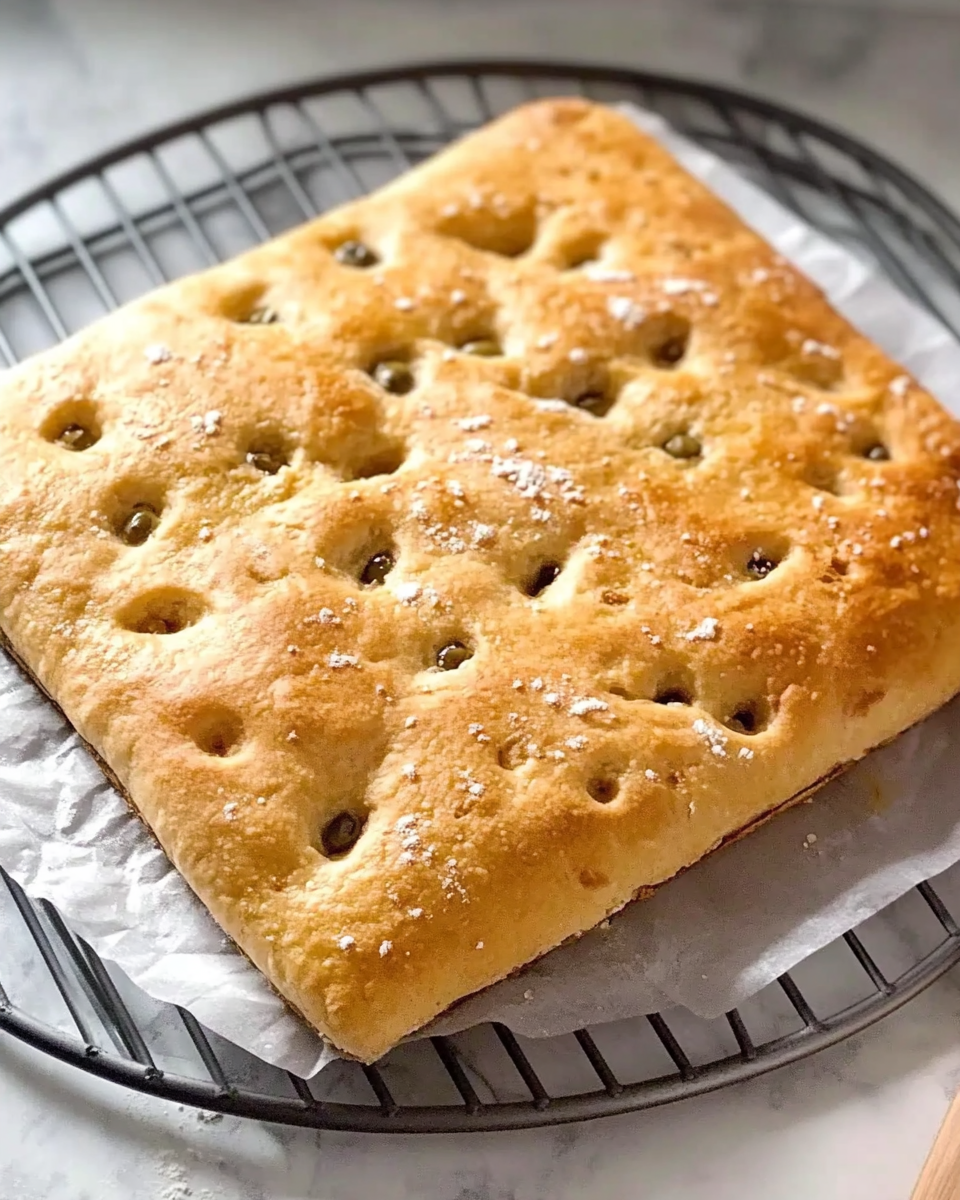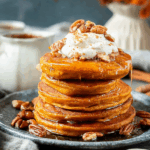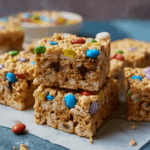Olive Focaccia is a classic Mediterranean bread that brings a perfect balance of rustic charm and savory flavors. The golden crust dotted with juicy olives and fragrant rosemary is inviting, while the interior remains soft and chewy, making each bite a delightful experience. Whether served alongside soups, salads, or enjoyed simply with olive oil for dipping, this bread elevates any meal with its vibrant, homemade appeal.
This recipe is wonderfully versatile and approachable, ideal for bakers of all skill levels. The simple ingredients come together in a dough that’s easy to handle and yields a beautifully textured loaf. It’s a great way to bring a touch of Italy into your kitchen and impress family and friends with your baking prowess. Plus, the aroma that fills your home during baking is irresistible!
Full recipe:
Ingredients:
-
2 1/4 teaspoons active dry yeast (1 packet)
-
1 1/3 cups warm water (110°F)
-
3 tablespoons olive oil, divided
-
3 1/2 cups all-purpose flour
-
1 tablespoon sugar
-
1 teaspoon salt
-
1 cup pitted green olives, sliced
-
1 teaspoon dried rosemary (optional)
-
Coarse sea salt, for sprinkling
Directions:
-
In a large bowl, dissolve yeast in warm water. Let stand until foamy, about 5 minutes.
-
Stir in 2 tablespoons olive oil, flour, sugar, and salt. Mix until the dough comes together.
-
Knead dough on a floured surface for about 8-10 minutes until smooth and elastic.
-
Place dough in a greased bowl, cover, and let rise in a warm place until doubled, about 1 hour.
-
Punch down dough and transfer to a greased baking sheet. Press dough into a 12×9-inch rectangle.
-
Cover and let rise again until doubled, about 30 minutes.
-
Preheat oven to 425°F (220°C).
-
Using fingers, make deep dimples all over the dough surface. Drizzle with remaining olive oil.
-
Evenly press sliced olives into the dough and sprinkle with rosemary and coarse sea salt.
-
Bake for 20-25 minutes or until golden brown. Remove from oven and let cool slightly before slicing.
Prep Time: 15 minutes | Rising Time: 1 hour 30 minutes | Cooking Time: 25 minutes | Total Time: 2 hours 10 minutes
Kcal: Approximately 220 kcal per serving | Servings: 8 servings
Why Olive Focaccia is a Timeless Classic
Olive focaccia is beloved because it is both straightforward to make and incredibly flavorful. The combination of olive oil and olives imparts a moist, slightly salty depth to the bread that makes it stand out from other breads. Olive oil is not only a key ingredient in the dough but also brushed on top before baking to create a golden crust with a subtle richness.
The texture of focaccia is unique — the dimples pressed into the dough before baking serve not only as a visual signature but also create pockets that hold olive oil and seasonings, ensuring each bite is moist and flavorful. This bread is hearty enough to stand alone, but also versatile enough to accompany soups, salads, or main dishes. Its ability to absorb dips and spreads, like balsamic vinegar or hummus, makes it a favorite for casual meals or festive gatherings.
Health Benefits of Olive Oil and Olives in Focaccia
Beyond taste, olive focaccia offers some nutritional benefits, largely thanks to its core ingredient: olive oil. Olive oil is rich in monounsaturated fats, which are known to support heart health by helping to lower bad cholesterol levels. It also contains antioxidants and anti-inflammatory properties that contribute to overall well-being.
Olives themselves bring fiber, vitamins, and minerals to the bread. Though olives are salty, they provide healthy fats and a small amount of protein. When eaten in moderation, olive focaccia can be part of a balanced diet, especially if paired with fresh vegetables or lean proteins.
Tips for Perfecting Your Olive Focaccia
Mastering olive focaccia involves understanding a few key techniques. The yeast fermentation process is crucial to achieve the bread’s airy texture and light crumb. It’s important to give the dough enough time to rise twice—once after mixing and once after shaping—to develop the right structure.
When handling the dough, avoid overworking it, as this can lead to a dense loaf. Instead, gently press the dough onto your baking surface and use your fingers to create those signature dimples. These indentations are not only decorative but serve to hold olive oil and toppings in place.
Choosing the right olives is another secret to success. Use pitted, firm olives with a robust flavor—green olives often work well because they add a bright, tangy bite. Black olives can also be used for a mellower, sweeter taste. Adding fresh or dried rosemary elevates the aroma and ties the bread to its Mediterranean roots.
Serving Suggestions and Pairings
Olive focaccia’s versatility means it fits into many meal occasions. It can be served warm or at room temperature, making it perfect for picnics or parties. It pairs beautifully with antipasto platters featuring cured meats, cheeses, and marinated vegetables. Dipping focaccia into olive oil infused with balsamic vinegar or fresh herbs enhances its flavor profile.
This bread also works well alongside hearty soups such as tomato basil or minestrone. For a light lunch, try slicing focaccia horizontally and stuffing it with fresh mozzarella, tomatoes, and basil for an Italian-style sandwich. It’s also an excellent base for bruschetta toppings or served alongside a fresh green salad for a simple yet satisfying meal.
Variations to Explore
While olive focaccia is delicious on its own, there are many ways to customize it. Some cooks add caramelized onions, sun-dried tomatoes, or olives of different varieties to create more complex flavors. You can experiment with different herbs like thyme, oregano, or sage depending on your preference.
For those wanting a bit of spice, adding crushed red pepper flakes or a drizzle of chili-infused olive oil before baking adds a subtle kick. Additionally, topping focaccia with flaky sea salt right before baking enhances the flavor and texture contrast.
For gluten-free or vegan eaters, focaccia recipes can be adapted using alternative flours or plant-based oils and substitutes, though the texture may vary slightly.
Why Baking Your Own Bread Matters
In a world filled with convenience foods, baking your own bread offers more than just nourishment. It’s an act of creativity and mindfulness. The process of mixing, kneading, and watching dough rise is rewarding and grounding. Baking bread at home lets you control the quality of ingredients, avoid preservatives, and tailor recipes to your own dietary needs.
Olive focaccia is an excellent bread for beginners because it’s forgiving and doesn’t require complicated techniques or equipment. Plus, the aroma of fresh-baked bread filling your home is one of life’s simple pleasures.
Conclusion
Olive focaccia is much more than just a bread; it’s a culinary experience steeped in history and tradition. Its combination of simple ingredients—flour, yeast, olive oil, and olives—results in a bread that’s flavorful, versatile, and satisfying. Whether you enjoy it as a snack, part of a meal, or an appetizer, olive focaccia has an undeniable ability to bring people together around the table.
Baking olive focaccia at home allows you to connect with Mediterranean heritage and enjoy fresh, wholesome bread that elevates everyday eating. With a few easy steps, anyone can create this rustic, aromatic bread that pleases both the eyes and the palate. So, embrace the process, experiment with toppings, and savor the delicious results of your homemade olive focaccia. It’s a timeless recipe destined to become a favorite in your kitchen.






